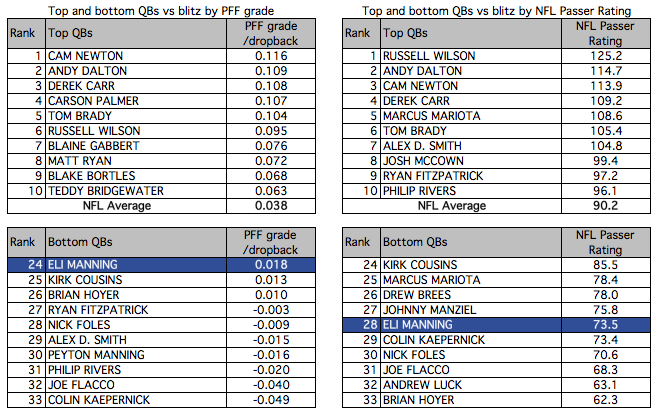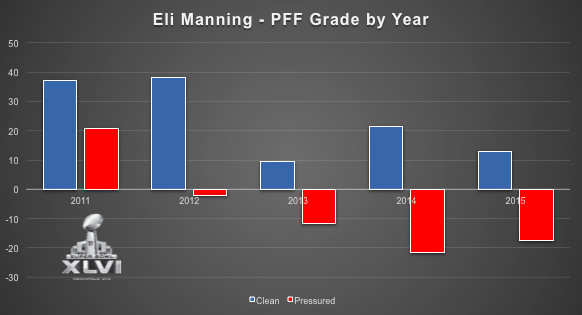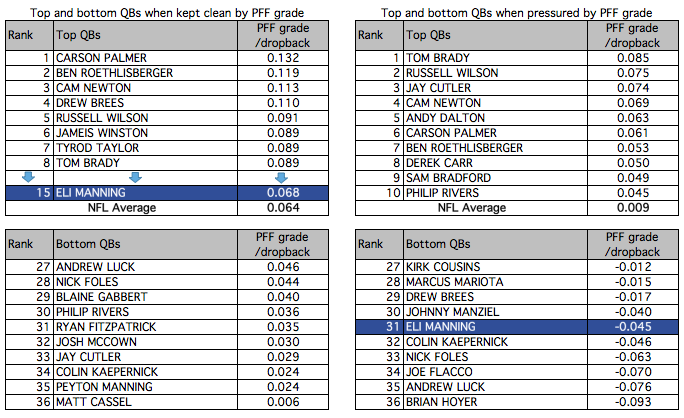I was engaged in a Twitter discussion the other day over the success (or lack thereof) that New York Giants quarterback Eli Manning—ranked 26th in overall grade among QBs in 2015—has had versus pressure in recent seasons, and ended up doing some research on how the QB has performed.
(Some of the argument had to do with semantics, as a recent article labeled Manning as being good at handling the blitz because he avoided sacks on blitzed plays at a high rate, but for the purposes of this article, we will define “versus the blitz” as when a defense rushes extra defenders, and “against pressure” as when a defense is able to affect a QB through a sack, hit or hurry.)
As it turns out, a lot of Manning’s recent dip in play has coincided with a drop-off in his performance when under pressure and when facing the blitz.
Let’s start with the blitz. As you can see from the charts below, this wasn’t a strong-suit for Manning last season:

Those numbers aren’t encouraging, but how does Manning do when the pass-rush actually gets to him? (That’s how we measure pressure at PFF.) It depends which time frame you look at.
When Manning last won the Super Bowl in 2011, his play under pressure was remarkable. He was the second-most-pressured quarterback in the league (after Philadelphia’s Michael Vick), and yet his adjusted completion percentage versus pressure of 69.1 percent was the second-best in the league behind only the Saints’ Drew Brees.
More importantly, Manning put together what I still consider to be the best playoff run by any signal-caller since we’ve been grading games here at PFF, finishing the year as PFF’s No. 5 QB while putting up off-the-chart grades in the playoffs overall—and in the Super Bowl, specifically.
But as his overall grades have dropped over the past four seasons, so have his grades versus pressure. The chart below displays his grades from a clean pocket in blue, and his grades when under pressure in red. While he’s been an above-average NFL passer each year when throwing from a clean pocket, he has been below-average every year when under pressure.

This season, the situation was as bad as ever, with Manning doing adequately with a clean pocket but terribly with defenders in his face.

In summary, if you’re looking for a reason for Manning’s overall decline in play the last few seasons, a good place to start is how he has performed when the opposing pass-rush got to him.
That’s a big problem entering 2016 if the Giants can’t provide better pass protection than they did last season. They ranked 22nd overall in the NFL in pass-blocking grades, and their tackle situation was particularly dire—left tackle Ereck Flowers earned the lowest mark in PFF’s pass-blocking efficiency metric as a rookie, while right tackle Marshall Newhouse ranked sixth-worst. The two combined to allow 120 total QB pressures.
The Giants made a lot of investments in their defense this offseason, from free-agent signings Olivier Vernon and Damon Harrison on the defensive line to No. 10 overall pick Eli Apple at cornerback. But perhaps the biggest key to the team’s success this season will be how well the offensive line can protect Manning, given how much he has struggled when under pressure the past two seasons.


 © 2024 PFF - all rights reserved.
© 2024 PFF - all rights reserved.